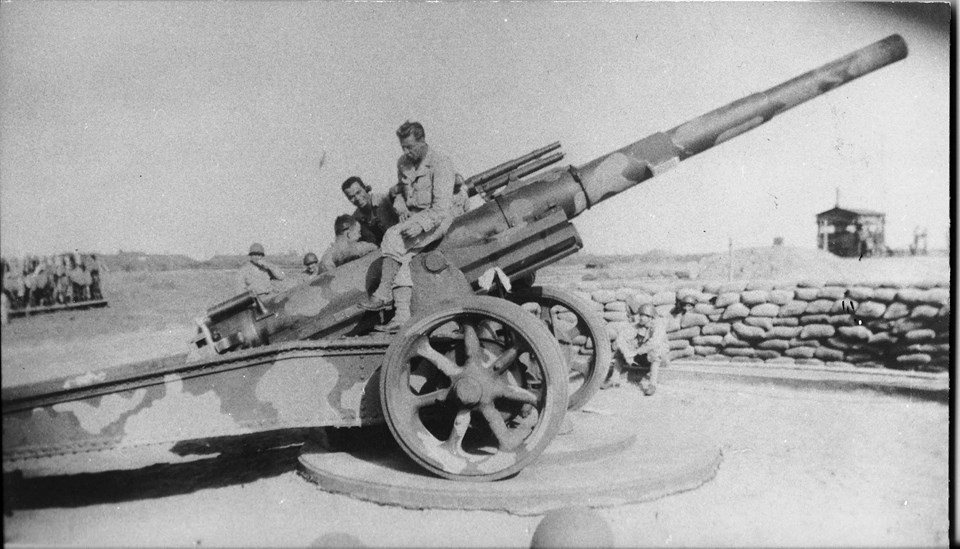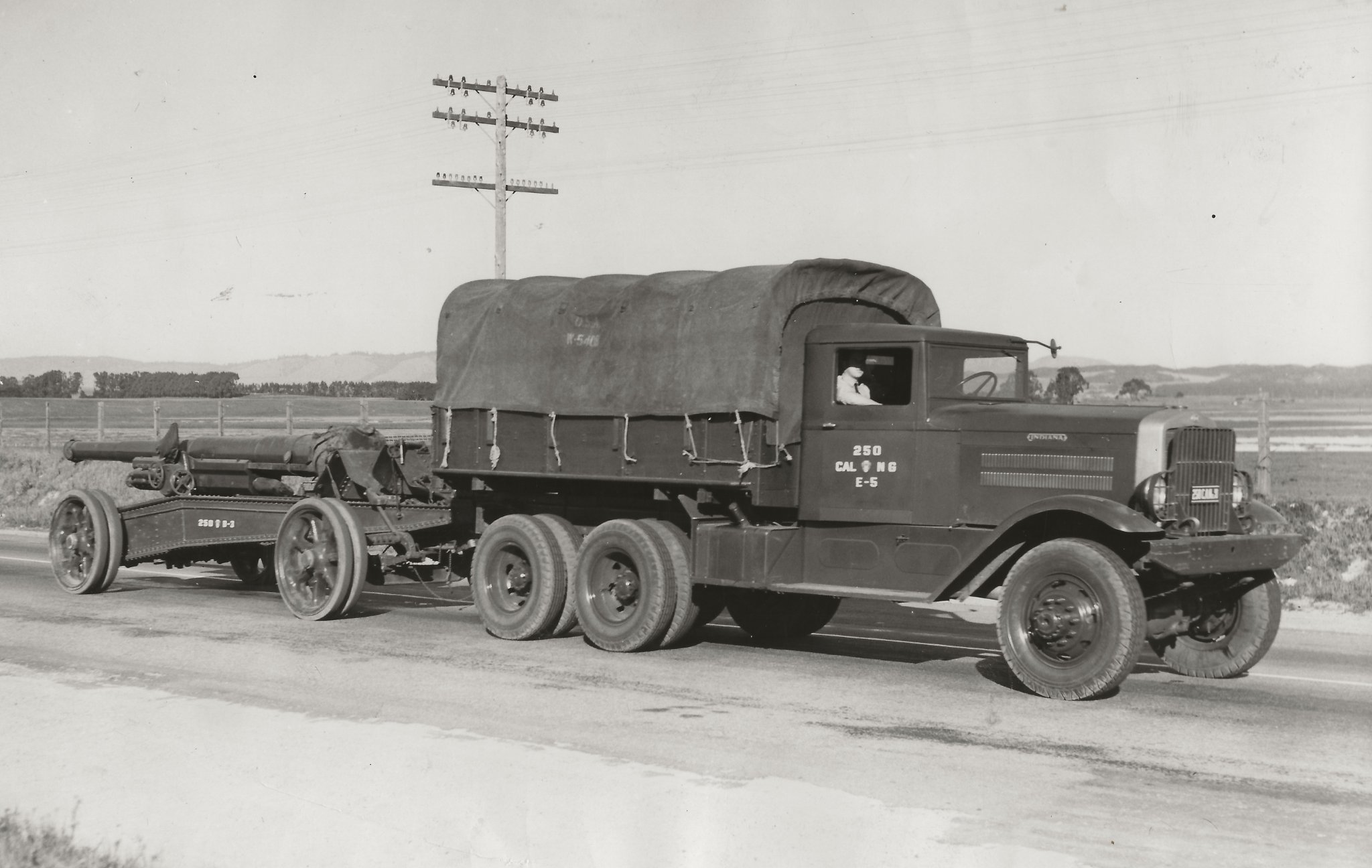Here we see a U.S. Model 1918M1 155mm gun, the famous French GPF (Canon de 155mm Grande Puissance Filloux, a direct copy of the C modèle 1917 Schneider) of the Great War, which equipped U.S. forces overseas and– when upgraded with air brakes, new metal wheels, and pneumatic tires to allow for high-speed towing– remained the mainstay of the interwar Army throughout the 1920s and 1930s.

Note the unmodified 1918-series profile, with hard rubber wheels and no air brake, in other words, in its original WWI-era mode, suitable for being pulled by slow tractors or horses. (Photo: Chris Eger)
By the outbreak of WWII, the Army had 979 GPFs still on hand although they were being replaced by the new and much more modern M114 155 mm howitzer (many of the latter are still in use in the Third World today).
With the relegation of the old GPF to the reserve, when the balloon went up and German and Japanese subs started crawling just off the U.S. coastline, these vintage guns were pressed into service on what was termed “Panama Mounts,” a semi-fixed installation atop a circular concrete mount that allowed the gun to revolve and rotate in place. Capable of sending a 95-pound shell out to 17,700 yards every 15 seconds with a well-trained crew, they could shatter the hull of a U-boat with ease or give a surface raider far from home at least a moment of pause.
One such gun (pictured above) remains at Fort Morgan, Alabama, controlling the entrance to Mobile Bay.
In 1942 the fort received four GPFs, two of which (Nos. 176 and 802) were used on Panama Mounts on top of the old Civil War-era bastions while two others were left mobile.

A soldier sitting on top of an M1918 155mm GPF, 1942. The gun position would be located on top of Bastion 3 of the fort. Note the camouflage, sandbag revetments and Panama Mount (Fort Morgan Collection)

Taken in 1943, this picture shows one of two 155 GPF guns that were mounted on top of the fort. Maximum elevation was 35-degrees, which is close to what this tube is (Fort Morgan Collection)
These were manned by men of Battery F, 50th Coast Artillery throughout the duration of the War. It should be noted that, while Fort Morgan was an active U.S./Confederate base from 1819 through WWI, by 1931 it had been disarmed and abandoned, with the visiting 155s of Battery F her last hurrah.
The French 155 was used by lots of CA units at the time, and was somewhat road-mobile.

Oakland Tribune-press photo of an M1918 Canon de 155mm GPF repurposed as a mobile seacoast gun belonging to San Francisco’s Battery E, 250th Coast Artillery Regiment, California National Guard, being pulled by a pre-1932 Indiana Truck Corporation 115 3-ton truck en route to the 1940 Fourth Army Maneuvers in Monterey County. Later that year, the 250th Coast Artillery Regiment would mobilize and deploy to reinforce the Harbor Defenses of Sitka, Alaska. California Military Department Historical Collection No. 2022.1.843.
Established at Camp Pendleton, Virginia 1 February 1942, the 50th Coast Artillery was a tractor-drawn heavy artillery regiment. After just two months of training, Battery F entrained for Fort Barrancas (Pensacola) Florida. Arriving there on 7 April 1942, the unit left in a (slow) motor convoy to Fort Morgan to establish Temporary Harbor Defenses (THD) of Mobile and remained there until 1944.
Battery E went down the coast another several miles to my hometown of Pascagoula to defend Ingalls Shipyard from a point on Beach Boulevard, but that is another story…

Morgan’s remaining GPF, head on. Yes, double solid rubber wheels on each side. (Photo: Chris Eger)

The gun still at Morgan is on M1918 carriage No. 429, one of the 626 U.S.-made produced under a license from Schneider/Puteaux. Another 577 were purchased from the French directly. All U.S.-made carriages were manufactured by Minneapolis Steel from built-up steel alloy. (Photo: Chris Eger)

Her tube is No. 1073, Watervliet Arsenal production. All gun tubes for U.S.-made M1917/18s were made by either Watervliet or Bullard Engineering Works and marked as such on the muzzle. (Photo: Chris Eger)

Technically a 155mm/38 caliber piece, the tube is almost 10 feet long (232.87 inches) with the weight of the gun and carriage topping 19,860 pounds, or right at 10 tons. The muzzle velocity on the 95-pound shell was 2,411fps– which translates to a whole lot of energy.
Their use in Coastal Artillery was nearly the last hurrah of the GPF in U.S. service.
By May 1941, the M1917/18 was a Lend-Lease item, and much of those stocks not used to guard the various beaches soon were on their way to the British, where they made an appearance in North Africa against Rommel and Co. The GPF also served in the Pacific, with at least 60 of the model captured by the Japanese in the Philippines.
Late in 1942, some 100 GPFs that remained in storage were mounted on the turretless chassis of the obsolete M3 Lee tank to form the M12 Gun Motor Carriage as a form of early self-propelled artillery. When teamed up with the companion Cargo Carrier M30 (also a turretless M3), which allowed them to go into the line with 40 rounds of 155mm ready, they proved popular in a niche role.

155mm M12 Gun Motor Carriage sniping strongpoints along the German Siegfried Line, late 1944/early 1945. At its core, it is a French 155 from the Great War

These tracked GPFs earned the nicknames “Doorknocker” and “King Kong” in service due to their ability to pierce up to seven feet of reinforced concrete and turn pillboxes into a smokey hole in the ground– a useful thing in Northeastern Europe in 1944.
Like this:

M12 Gun Motor carriage used in direct firing mode against a fortified German position during the Battle of Aachen in October 1944.

If visiting Fort Morgan, be sure to check out the small museum just a few hundred yards from where the surviving GPF sits.
Inside the museum they have the guidon of Battery A, 104th Coastal Artillery, an Alabama National Guard unit mobilized for federal service 10 months prior to Pearl Harbor and then shipped to the Pacific in 1942, only returning home in January 1946.


104th Artillery patch
As well as the typical WWII Coastal Artillery uniform of sun hat, olive coveralls tucked into canvas leggings, gas mask, and cartridge belt:

Of note, interwar Coastal Artillery coveralls were blue denim but were often worn by National Guard units operating 155mm GPFs in WWII, such as one of these big guns going boom, shown in the late 1930s Kodachrome below.









































